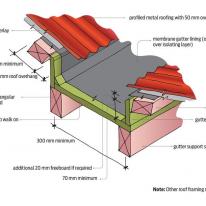Internal gutters – leaks
Repair
-
investigate the possibility of adding additional outlets or enlarging the gutter width or depth. Enlarging the gutter will not be easy and is best done at the same time as reroofing
-
given the fact that internal gutters can be problematic and increase the risk of leaks in a roof, any construction work on them should be carried out by a person with the appropriate skills, experience and equipment. This is not work for a novice. Work on roofs is restricted building work under the Building Act and anyone engaged to carry out this work must be a licensed building practitioner or be supervised by an LBP
-
gutters should be large enough to cope with the roof size and the maximum rainfall intensity for the region. One way to calculate this can be found in the Acceptable Solutions E1/AS1 and E2/AS1
-
• E1/AS1 shows (in Appendix A) rainfall intensities for different areas of New Zealand. Figure 16 provides a graph from which to determine internal gutter sizes based on a rainfall intensity of 100 mm/hour. Where the rainfall intensity exceeds 100 mm/hour, the minimum gutter cross-sectional area, based on roof pitch, can be worked out from the graph
-
E2/AS1 requires internal gutter dimensions to be at least 300 mm wide and 70 mm deep (plus 20 mm freeboard, so total depth is 90 mm) – see Figure 1. This gives a cross-sectional area of 21,000 mm². If a larger cross-sectional area is required to comply with E1/AS1, the depth or width of the gutter must be increased
-
to add a greater margin for safety, BRANZ recommends designing (a) for a rainfall intensity of 200 mm/hour to increase the gutter capacity and (b) with greater fall – 1:60 – than the minimum required (1:100)
-
alternative methods of sizing gutters are provided in the NZ Metal Roof and Wall Cladding Code of Practice v3.0. This provides a more up-to-date method than E1/AS1 and E2/AS1, incorporating more factors
-
if there are downpipes and/or spreaders that discharge directly into the gutter, investigate whether they can be redirected to another gutter
-
if there is no overflow, investigate whether it is possible to provide an overflow outlet below the top of the gutter in an obvious location to give early warning of problems, or (even better) an additional outlet
-
where it is suspected that water has been entering the building over a period of time and there is a risk of damage below the roof, engage a building surveyor to report
-
check the gutter annually for damage or deterioration to the lining and outlet(s)
Cause
Unusually heavy rainfall
Repair
- as above
Cause
Blockages
Repair
-
clear debris out of the gutter and/or overflow (aim to do this every three months)
-
if blockages are caused by leaves, trim back branches that overhang the roof until they are well clear
-
install dome-type leaf guards to keep out debris, and snow guards in areas with snowfall
-
if there are downpipes and/or spreaders that discharge directly into the gutter, investigate whether they can be redirected to another gutter
-
if there is no overflow, investigate whether it is possible to provide an overflow outlet below the top of the gutter in an obvious location to give early warning of a blockages, or (even better) an additional outlet
-
where it is suspected that water has been entering the building over a long period of time and there is a risk of damage under the roof, engage a registered building surveyor to report on the building
-
check the gutter annually for damage or deterioration to the lining and outlet(s)
Cause
Membrane or metal joint failure
Repair
-
failed joints in internal gutters should be repaired as soon as possible to minimise any potential damage from leaks.
-
given the fact that internal gutters can be problematic and increase the risk of leaks in a roof, any construction work on them should be carried out by a person with the appropriate skills, experience and equipment. This is not work for a novice. Work on roofs is restricted building work under the Building Act and anyone engaged to carry out this work must be a licensed building practitioner or be supervised by an LBP
-
where it is suspected that water has been entering the building over a period of time and there is a risk of damage, engage a building surveyor to report on the building
-
check the gutter annually for damage or deterioration to the lining and outlet(s)
Cause
Corrosion of metal
Repair
-
failed internal gutters should be repaired or rebuilt as soon as possible to minimise any potential damage from leaks.
-
given the fact that internal gutters can be problematic and increase the risk of leaks in a roof, any construction work on them should be carried out by a person with the appropriate skills, experience and equipment. This is not work for a novice. Work on roofs is restricted building work under the Building Act and anyone engaged to carry out this work must be a licensed building practitioner or be supervised by an LBP
-
where it is suspected that water has been entering the building over a period of time and there is a risk of damage, engage a building surveyor to report on the building
-
check the gutter annually for damage or deterioration to the lining and outlet(s)





